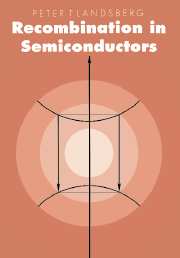Book contents
- Frontmatter
- Contents
- List of main symbols
- Note on units
- Introduction
- 1 Semiconductor statistics
- 2 Recombination statistics
- 3 Auger effects and impact ionization (mainly for bands)
- 4 Radiative recombination (mainly for bands)
- 5 Defects
- 6 Multiphonon recombination
- 7 Recombination in low-dimensional semiconductor structures
- Appendix A The delta function (section 3.2)
- Appendix B Useful identities arising from the periodic boundary condition (section 3.4)
- Appendix C Fourier expansions (section 3.4)
- Appendix D The effective mass sum rule and the dynamics of Bloch electrons (section 3.6)
- Appendix E Diagonalization and Jacobian for the threshold energy and impact ionization calculation (section 3.5.7)
- Appendix F The saddle-point method, and the method of stationary phase (section 6.3)
- Appendix G Evaluation of the integral (6.6.12) (section 6.6)
- References
- Index of names
- Index of topics, concepts and materials
6 - Multiphonon recombination
Published online by Cambridge University Press: 22 September 2009
- Frontmatter
- Contents
- List of main symbols
- Note on units
- Introduction
- 1 Semiconductor statistics
- 2 Recombination statistics
- 3 Auger effects and impact ionization (mainly for bands)
- 4 Radiative recombination (mainly for bands)
- 5 Defects
- 6 Multiphonon recombination
- 7 Recombination in low-dimensional semiconductor structures
- Appendix A The delta function (section 3.2)
- Appendix B Useful identities arising from the periodic boundary condition (section 3.4)
- Appendix C Fourier expansions (section 3.4)
- Appendix D The effective mass sum rule and the dynamics of Bloch electrons (section 3.6)
- Appendix E Diagonalization and Jacobian for the threshold energy and impact ionization calculation (section 3.5.7)
- Appendix F The saddle-point method, and the method of stationary phase (section 6.3)
- Appendix G Evaluation of the integral (6.6.12) (section 6.6)
- References
- Index of names
- Index of topics, concepts and materials
Summary
Introduction
Multiphonon processes in semiconductors belong to a family of electron transfer reactions which spreads over physics, chemistry and biology [6.1.1]. A theory of these processes describes how and in what circumstances electronic energy (ranging from few tenths of an electronvolt to an electronvolt or more) can be converted into the energy of nuclear vibrations. Since a phonon carries much less energy, many phonons must be absorbed or emitted during the transition – hence the name multiphonon transitions. In this chapter, we shall be concerned solely with multiphonon (‘MP’) transitions at defects which occur with the participation of the defect levels in the band gap, and a brief review of these defect states forms therefore an appropriate starting point for a discussion of this subject.
The best known examples of impurity levels in the band gap of a semiconductor are the discrete energy levels of charged donors or acceptors, modeled most simply as in eqs. (1.8.2)–(1.8.4). In most covalent semiconductors the resulting shallow levels lie close to the respective band edge (within 0.1 eV or so) and the wavefunction spreads over a region extending over many lattice constants. The closely spaced excited states provide a suitable medium for cascade transitions (section 2.6). In ionic solids, the Coulomb potential of charged defects is stronger and it can bind electrons in states with energy levels deeper in the band gap.
- Type
- Chapter
- Information
- Recombination in Semiconductors , pp. 447 - 480Publisher: Cambridge University PressPrint publication year: 1992
- 1
- Cited by

